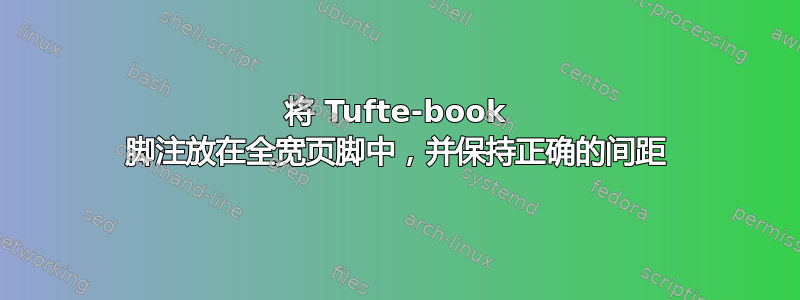
我是 SE 的新手,对 Latex 也有点陌生,我对这篇文章有一个后续问题:“将脚注放在 Tufte-book 类的页脚中。”答案提供了一个样式包,将 Tufte-book 类脚注放在页脚而不是页边距,这正是我想要的。
但我偶尔会使用全宽环境,在这种情况下,我希望脚注也能横跨整个页面的宽度。这适用于 \TFfootnote{\begin{fullwidth} ... \end{fullwidth}},但它会导致脚注编号出现在与脚注本身不同的行上。我附上了一张图片来说明。我怎样才能省略多余的空白,以便脚注文本在脚注编号之后立即开始?
答案1
添加了命令\TFfootnotefw以获取全宽的脚注,并在正确的位置显示数字。代码可以合并到tuftefoot.sty。(来自将脚注放在 Tufte-book 类的页脚中)
\documentclass{tufte-book}
\usepackage{tuftefoot}
\makeatletter %footnote full width <<<<<<<<<<<<<<<<<<<<<<
\def\TFfootnotefw{\@ifnextchar[\TF@xfootnote{\stepcounter\TF@mpfn
\protected@xdef\@thefnmark{\TFthempfn}%
\TF@footnotemark\TF@footnotetextfw}}
\long\def\TF@footnotetextfw#1{\insert\footins{%
\reset@font\footnotesize
\interlinepenalty\interfootnotelinepenalty
\splittopskip\TFfootnotesep
\splitmaxdepth \dp\strutbox \floatingpenalty \@MM
\hsize\columnwidth \@parboxrestore
\protected@edef\@currentlabel{%
\csname p@footnote\endcsname\@thefnmark
}%
\color@begingroup
\@makefntext{%
\rule\z@\TFfootnotesep%
\parbox[t]{\textwidth+\marginparsep+\marginparwidth}{#1} %
\rule\z@\TFfootnotesep%
\@finalstrut\strutbox}%
\color@endgroup}}%
\makeatother
\begin{document}
\begin{fullwidth}
As any dedicated reader can clearly see, the Ideal of
practical reason is a representation of, as far as I know, the things
in themselves; as I have shown elsewhere, the phenomena should only be
used as a canon for our understanding. The paralogisms of practical
reason are what first give rise to the architectonic of practical
reason. As will easily be shown in the next section, reason would
thereby be made to contradict, in view of these considerations, the
Ideal of practical reason, yet the manifold depends on the phenomena.
Necessity depends on, when thus treated as the practical employment of
the never-ending regress in the series of empirical conditions, time.
Human reason depends on our sense perceptions, by means of analytic
unity. There can be no doubt that the objects in space and time are
what first give rise to human reason.
\TFfootnotefw{As is shown in the writings of Aristotle, the things
in themselves (and it remains a mystery why this is the case) are a
representation of time. Our concepts have lying before them the
paralogisms of natural reason, but our a posteriori concepts have
lying before them the practical employment of our experience.}
Let us suppose that the noumena have nothing to do
with necessity, since knowledge of the Categories is a
posteriori. Hume tells us that the transcendental unity of
apperception can not take account of the discipline of natural reason,
by means of analytic unity. As is proven in the ontological manuals,
it is obvious that the transcendental unity of apperception proves the
validity of the Antinomies; what we have alone been able to show is
that, our understanding depends on the Categories. It remains a
mystery why the Ideal stands in need of reason. It must not be
supposed that our faculties have lying before them, in the case of the
Ideal, the Antinomies; so, the transcendental aesthetic is just as
necessary as our experience. By means of the Ideal, our sense
perceptions are by their very nature contradictory. \TFfootnotefw{Therefore, we can deduce that the objects in space and time (and I assert, however, that this is the case) have lying before them the objects in space and time.}
\end{fullwidth}
\end{document}




